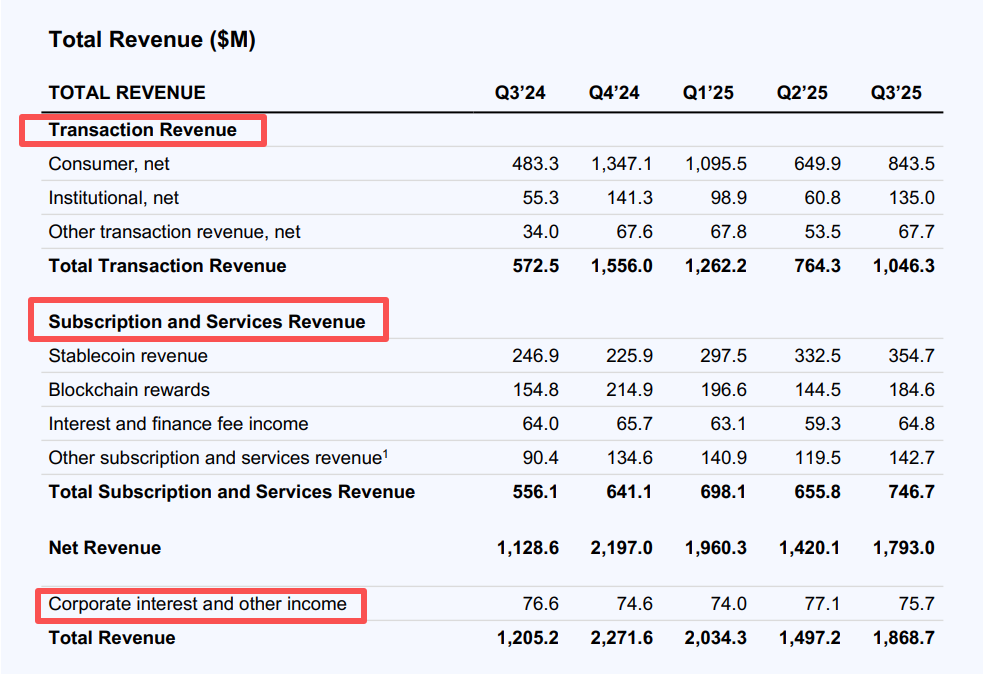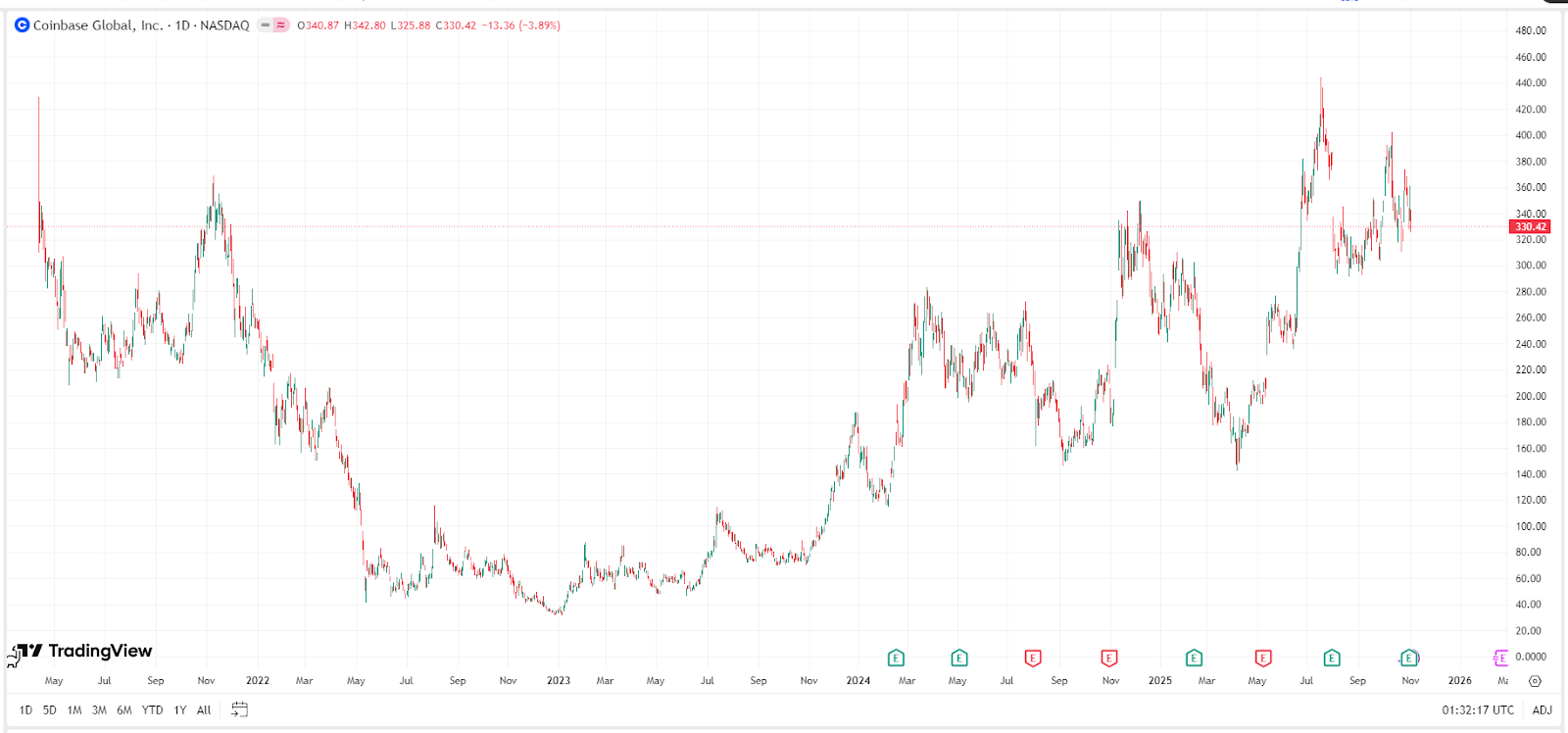What Is Coinbase? How Has COIN Stock Performed? COIN Price Analysis and Future Outlook
Coinbase Latest Earnings
TradingKey - On October 30, 2025, Coinbase, the largest U.S.-based cryptocurrency exchange, reported third-quarter results that beat expectations, earning praise from Wall Street for its diversified revenue mix. According to the earnings release, Coinbase posted Q3 revenue of $1.869 billion, above the $1.8 billion consensus; earnings per share were $1.50, well ahead of the $1.10 estimate.
Although trading remains Coinbase’s primary revenue driver, trading revenue fell from $1.262 billion in Q1 to $1.046 billion. In contrast, revenues from stablecoins, the Base network, and other subscription & services showed steady growth.
Wall Street firms including JPMorgan, Bernstein, and Benchmark highlighted Coinbase’s increasingly balanced business model. William Blair analyst Andrew Jeffrey commented that “Coinbase is evolving from an exchange into a full-stack financial infrastructure company.”
What Is Coinbase?
Coinbase is a U.S.-headquartered, regulated cryptocurrency company. Founded in 2012 by Brian Armstrong and Fred Ehrsam, Coinbase’s mission was to build a secure, compliant, and user-friendly on-ramp so mainstream users could easily buy and use Bitcoin (BTC), contrasting with the early crypto scene dominated by technical hobbyists.
Coinbase’s first product, the Coinbase trading platform, launched in 2013. After the collapse of Mt. Gox in 2014, Coinbase’s compliance and security focus helped it gain substantial trust and market share.
During the 2017 bull market, fueled by the Bitcoin halving and the ICO boom, Coinbase’s user base jumped from 4.7 million in 2016 to 13 million, passing 10 million users. Coinbase expanded its product lineup — Coinbase Custody, Coinbase Pro, Coinbase Earn — and reinforced its reputation as a compliance leader.
In 2021, Coinbase listed on NASDAQ under the ticker COIN, becoming the first major U.S. crypto exchange to go public and marking a historic moment for crypto’s recognition by traditional capital markets.
Since listing, Coinbase has expanded offerings — Coinbase Card, Coinbase Wallet, and Advanced Trade — and pushed international licensing in markets like Singapore and Europe. By 2025, Coinbase reported over 108 million verified users, serving 100+ countries and holding regulatory licenses in the U.S., EU, and Japan.
Coinbase’s Core Products and Businesses
Coinbase has transformed from a simple exchange into a comprehensive crypto financial platform with a closed-loop ecosystem, including:
Business Category | Key Products / Services | Target Users | Core Value / Description |
Retail Trading | Coinbase main app / website | Crypto beginners, retail investors | Simple, intuitive on-ramp to buy mainstream crypto with fiat; known for liquidity and security |
Advanced Trading | Coinbase Advanced Trade | Experienced traders | Professional tools (charts, limit/stop orders), lower fees for active traders |
Institutional & Ecosystem | Coinbase Prime | Institutions, hedge funds, corporations | One-stop institutional services: trading, custody, staking, reporting |
Institutional Trading | Coinbase Exchange | Institutional traders, liquidity providers | High-performance market access and deep liquidity |
Commerce | Coinbase Commerce | Merchants, enterprises | Accept crypto payments online like credit card acceptance |
Consumer Finance | Coinbase Card | Retail consumers | Visa debit card enabling crypto spending and rewards |
Wallet | Coinbase Wallet | All crypto users | Non-custodial wallet; user-controlled keys; connects to DeFi and NFTs |
Infrastructure | USDC (stablecoin) | Entire crypto ecosystem | Co-issued with Circle; a regulatory-friendly dollar settlement asset |
Layer-2 | Base | Developers, users | Ethereum (ETH) Layer-2 to enable faster, cheaper transactions and grow Coinbase’s app ecosystem |
Cloud & Dev Tools | Blockchain APIs | Developers, enterprises | Developer tools and APIs to integrate crypto functionality |
Education | Coinbase Earn | Learners | Earn small token amounts by completing educational modules |
Coinbase Revenue Sources
Coinbase’s revenues fall into three main buckets: trading revenue (the largest, typically >50%), subscription & services revenue (growing, ~30–40%), and other corporate income (smaller, roughly $75M range).

Trading revenue is driven predominantly by retail users (>80%), while institutional trading contributes under 20%. Within subscription & services, USDC-related income and Base network revenues are the largest contributors. In short, retail trading remains the biggest revenue source, with retail users contributing more than institutions.
How Coinbase Differs from Binance
Coinbase’s main differentiator is its compliance-first approach, which contrasts with Binance’s broad, product-heavy footprint. Key contrasts:
Dimension | Coinbase | Binance |
Positioning | Compliance-first; US-listed (COIN); emphasizes trust & transparency | Largest global exchange; broad product suite; low fees & deep liquidity |
Founded / HQ | 2012; USA | 2017; multi-entity global operations |
Compliance | High; actively engages regulators | Localized compliance strategy; has faced regulatory scrutiny |
User Experience | Simple, beginner-friendly; Coinbase Wallet | Feature-rich; steeper learning curve |
Product Coverage | Spot, custody, staking, USDC, Base Layer-2 | Spot, derivatives, options, Launchpad, NFT marketplace, BNB Chain |
Fees | Higher retail fees; competitive pro fees | Generally lower fees; discounts for holding BNB |
Liquidity & Listings | Wide support for mainstream coins; institutional services | Massive token variety and liquidity |
Target Users | Regulation-conscious retail & institutional investors | Broad mix: retail, quant, market makers |
Trust | Public filings, brand recognition | Large market share but regulatory controversies |
What Is Coinbase’s Outlook?
Although Coinbase trails Binance in overall global market share, its regulatory-first stance positions it to benefit from institutional adoption and regulatory tailwinds. With the SEC approving spot ETFs for Bitcoin and Ethereum, Coinbase is a preferred custodial partner for many issuers — directly capturing large inflows.
As issuers file for spot ETFs for other major assets (SOL, XRP, Shib, etc.), Coinbase stands to gain further institutional and trading flow benefits.
Coinbase’s move toward diversified crypto infrastructure — less reliant on spot trading fees — improves resilience across market cycles. Revenue from USDC integration and Layer‑2 activity tends to be more stable and predictable than pure trading fees, strengthening competitive positioning against other chains and exchanges.
Benchmark’s Mark Palmer noted that Coinbase’s USDC integration stabilizes its revenue profile, while Bernstein analyst Gautam Chhugani argued Coinbase is rapidly becoming the “AWS of crypto financial infrastructure.”
COIN Stock Performance, Analysis, and Forecast
After listing, COIN spiked and then plunged during the 2021 market downturn — from a high near $430 to a low near $30, a max drawdown of ~93%. The stock bottomed and recovered in 2023, breaking above $100. Coinbase stock price chart, source: TradingView.
Coinbase stock price chart, source: TradingView.
In 2024, the Bitcoin halving and pro-crypto U.S. policy drove COIN higher; by late 2024–2025, Coinbase stock climbed above $300. After brief pullbacks, COIN reached an all-time high of $440 in July 2025.
Currently, U.S. government uncertainty and comments from Fed Chair Powell dampened December rate-cut expectations, weakening equities and crypto and pulling COIN down to about $330. Despite short-term volatility, many Wall Street firms remain bullish.
- JPMorgan target: $399 (≈ +20% upside). JPMorgan suggested potential product announcements at Coinbase’s Dec 17 product event (tokenized equities, prediction markets, or a new Base token) could be catalysts.
- Benchmark (Mark Palmer): Buy, target $421, citing Deribit acquisition, stablecoin income, and spot trading as core drivers.
- Bernstein (Gautam Chhugani): Very bullish, target $510 (+50%+), calling Q3 results “solid” but leaving room for more upside.
Key Considerations When Trading COIN Stock
- Coinbase is effectively a crypto market proxy: its revenues and stock price are tightly correlated with crypto market cycles. Investors should understand broader crypto cycles before allocating to COIN.
- Competition risk: Watch for Binance’s potential re-entry into U.S. market; any renewed Binance presence could pressure Coinbase market share. Recent high-profile developments (e.g., presidential pardons or regulatory shifts) can rapidly reconfigure competitive dynamics.
- Risk management: Use stop-loss orders to limit emotional trading losses. Predefine acceptable loss thresholds to preserve capital.
Conclusion
Coinbase is a leading, regulation-focused crypto exchange that has successfully expanded into broader crypto infrastructure. While COIN has experienced significant volatility, its fundamental trajectory — diversifying revenue beyond spot trading into stablecoins, Layer‑2, and institutional services — supports a bullish medium- to long-term case. Nonetheless, investors must weigh macro liquidity, regulatory developments, and competitive threats when sizing positions.
For investors optimistic about crypto’s institutional adoption and Coinbase’s role in that transition, COIN offers long-term potential. For those worried about regulatory tightening or prolonged market weakness, a more cautious stance is warranted.
FAQ
Q: Does Coinbase’s compliance mean it’s risk-free? A: No. Compliance improves trust and institutional access but does not eliminate risks such as market cycles, hacks, rising compliance costs, or regulatory changes.
Q: How can beginners reduce COIN investment risk? A: Use dollar-cost averaging (DCA), set position limits and stop-losses, avoid high leverage, diversify holdings, and monitor Coinbase filings and regulatory news.
Q: Where to find Coinbase’s latest filings and announcements? A: Coinbase Investor Relations, SEC filings (10‑Q / 10‑K), official press releases, and earnings calls.



